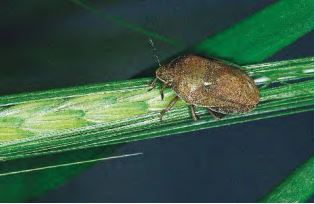Symptoms, description and lifecycle
Sunn pest is a sap-sucking bug that feeds on grain crops, damaging leaves, stems and grain heads. Symptoms include yellowing and dieback of the stem and leaves, and stunting of the growth of tips and buds. Feeding on other parts of the plant causes abnormal flower formation and discolouration. Feeding before grains develop can result in grain abortion or, if feeding occurs only after development, the grains are left shrivelled, discoloured (white) and/or empty.
Adults are 10-13 mm long, brownish is colour and have a wide triangular head and oval-shaped body. They have sap sucking mouth parts. Their wings are completely hidden by a hardened ‘shield’ that covers most of the body.
Nymphs are smaller and rounder in shape and normally dark brown to black. Eggs are light green in colour and are laid in two even rows on host plant leaves.
Organism
Eurygaster infegriceps
Conditions favouring pest
Sunn pest survives temperatures between -30°C to 45°C, and is unlikely to survive past 49.5°C. Adults can survive for up to a year, where they will move to cracks in the soil or beneath leaf litter until conditions are favourable. Most severe outbreaks typically occur when grain maturity and nymph phase occur at the same time, which enables the pest to build fat reserves.
Host range
Sunn pest feeds on wheat, durum, rye, oats, sorghum and barley.
Method of spread
Sunn pests can fly over large distances. Adults migrate up to 250 km, particularly in areas with continuous crops. Sunn pest can also survive long periods in the soil without food and can be spread with the movement of machinery or equipment.
Confused with?
There are several shield bugs native to Australia some of which look similar to Sunn pest. These include the small brown stink bug, Caystrus pallidolimbatus and the brown shield bug; Dictyotus caenosus.
Where?
Found in parts of North Africa, West and Central Asia and Eastern Europe.

Image 32. Adult Sunn pest.
Source: ICARDIA.


